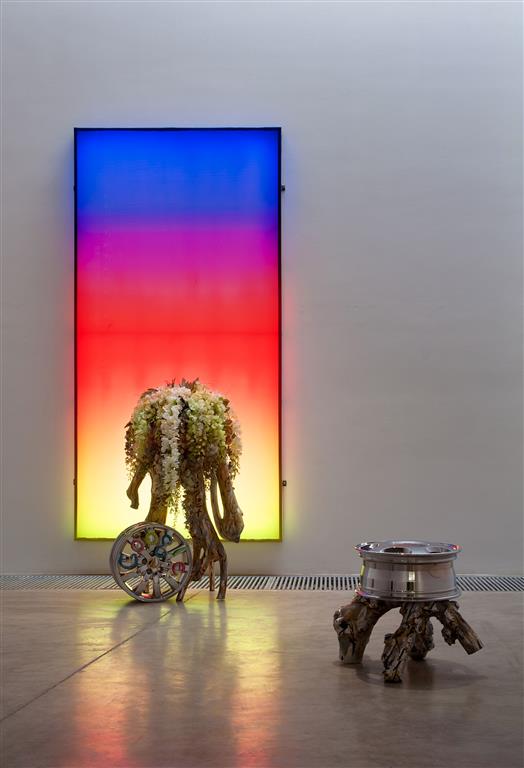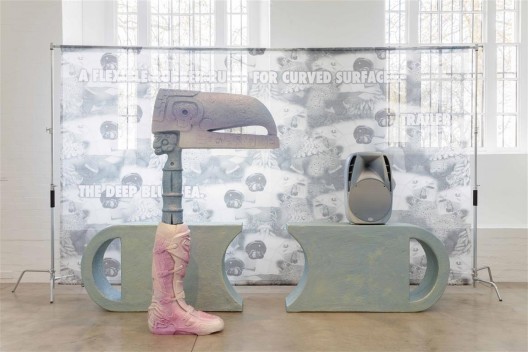This piece is included in Ran Dian’s print magazine, issue 4 (Winter 2016–2017)
In nova fert animus mutatas dicere formas corpora (I intend to speak of forms changed into new entities) —Ovid, Metamorphoses
Ovid opens the Metamorphoses (AD 8) with an explicit statement of intent. In the 250 myths that follow, the Roman poet chronicles the subject of transformation—sometimes in an arbitrary fashion, sometimes retelling well-known Greek fables, and sometimes straying in other, unexpected directions. One of these stories, which entered our collective consciousness, can be seen at Rome’s Galleria Borghese, where Giovanni Bernini’s famous sculpture tells the tale of the nymph Daphne in mid-metamorphosis—her limbs turning into the twines of a laurel tree as she escapes from the love-stricken Apollo. Transformations occur in our everyday lives, too; we experience this in cinema, as film scores transport audiences sonically through visual imagery. In Ikon of Light (1983), for instance, the composer Sir John Tavener articulates the transformation of matter between the duality of absence and the fullness of light in music. The work is an expression of light in sound—light as both a physical illumination and a resplendent spirit. This fluidity and mutability of the sonic and the visual can equally be found in performative practices: in both classical Indian dance and Beijing Opera productions, a multitude of hand gestures and movements communicate a very distinct narrative meaning. Gestures, then, can be heard, music seen, and literature transmogrified.

Guan Xiao, too, is interested in all kinds of transitions between forms, be they intermedia or conceptual. She explores how contemporary ways of seeing are influenced by digital imagery in a world of hyper-interconnectedness. By way of example, she has previously referenced (in a Frieze “Portfolio” piece in which she describes her sources of inspiration) a news event from 2013 showing a group of Russian photographers taking pictures of a gigantic meteor. We receive such imagery via social media platforms day in, day out. Technology telescopes us into other times and other places, collapsing geography and temporality and resulting in a state that means we no longer operate in a singular moment—one that opens the technological object to repetition (and even distortion). What we physically see can be transformed, as can the way in which we view it. In Guan’s own words: “What is shown is now very common: an image of an event being documented and so widely circulated to the extent that the event itself ceases to be the subject. The image is no longer in the service of the event; it’s the other way around.”
It is within this fluid framework that Guan Xiao presents two new works, “How to Disappear” (2016) and “Weather Forecast” (2016), in Jeu de Paume’s 9th Satellite program entitled “Notre océan, votre horizon / Our ocean, your horizon.” An installation consisting of sound, video on a small screen, and a projection of disappearing text, “How to Disappear” includes a soundtrack composed of three intermingling voices, each speaking a different language and announcing a disappearance, after which the image and the sound effectively vanish. As we reorient ourselves, we begin to think about the difference between discussing a disappearance and actually experiencing an absence. This is exactly what Guan Xiao wants to achieve—an environment that makes visitors more aware of their cognitive processes. We become almost hyperaware of our senses and what might occur next. She sees this artwork very much as a preface to her next work in the exhibition. It’s as if “How to Disappear” forms the first part of a diptych to her show at Jeu de Paume, priming the viewer to fully experience “Weather Forecast”.
The three-channel video “Weather Forecast” presents a more vivid look at the possibilities for conceptual transformation. Taken from footage found on the internet (a frequent source for the artist and a process she describes as “them finding her” rather than the other way around), the videos use travel as a metaphor to convey the parameters of conceptual transformation. Just as travel can transform us, so can a concept, a thing, and even human beings and animals. The artist chose “Weather Forecast” as the title because weather, in its very nature, is an impermanent, fluctuating, amorphous phenomenon. It is both an abstraction and an apt apparatus through which Guan Xiao can weave her narrative of change.
The video, although nonlinear, is separated into three sequential parts spread over three screens. In each segment, Guan uses images and video that, in her words, share “the same rules or logic.” In her narration of these sections, which informs processes of transformation that occur in the work, she attempts to correlate one piece of subject matter to the next. Between each sequence, a text appears on all three screens that reads: “How can you view Europe from a chair?” Guan Xiao suggests that the phenomenological change that takes place through travel and from experiencing new sights and sounds is a transformation that can be provided in your own home.
What is fascinating in this is that Guan Xiao’s work itself becomes an agent for transportation. In the science fiction world, transporters (à la Star Trek) convert a person or object into an energy pattern or dematerialized form before “beaming” it to a destination, where it is reconverted into matter, or rematerialized. Guan Xiao poses a question by typing in coordinates that her viewership might choose to accept. Is physical movement from one place to another necessary for transformation to take place? What else can we beam across the world? If we needn’t travel to experience other places, how might we identify ourselves or where we are from in the first place? Although the artist does not directly focus on ideas of identity in this particular case, she does allude to how identity can transform from one thing to another.
Guan recently had her first solo show in the United Kingdom, “Flattened Metal”, at London’s Institute of Contemporary Arts (ICA). The exhibition included a new installation comprising five large printed screens in front of which were placed sculptures composed of various materials, including muted speakers. The assemblage of objects conflated history, transforming linear assumptions of time. For instance, in one work, a replica of a seventh- to tenth-century Amazonian bird head, remade using resin and fiberglass, sat above what looked like the handle of an ancient scepter. These two pieces, which appear to have been sourced from antiquity, interacted with a high-tech racing boot to form a strange composite structure that perhaps belonged in the future. This work reiterates the artist’s interest in finding formal equivalences between objects that are dissimilar in time, place, and purpose. In her view, “whether a plant, a human, or an animal, the process of how they feel the world is exactly the same.” In a world where the internet provides a platform where voices are commeasurable, Guan Xiao, with this work, seems to ask how we might create our own hierarchies amid new information.
In “Action” (2014), a three-channel work that was also included in the London exhibition, the artist likewise integrates sound, text, and images to produce a visual journey. The three screens display a rhythmic harmony: hands clap while feet tap, and as the pages of a book turn on one screen, a girl’s hair flies in the wind on another. On the central screen, text displays Guan’s inner musings: “For me, rhythm means all the intersections of sense. It’s a way I understand the associations between things. It helps me to try and transfer action, see, listen, think about interactions and freely build a link between them.”
This way of seeing rhythm visually, through imagery within moving image work, reminds me of how a musical score can carry out the visual sensibilities of a film. Birdman (2014), directed by Alejandro Iñárritu and scored by Antonio Sánchez, comes to mind. Sánchez, a jazz percussionist, was tasked with finding “the internal rhythm of the film.” An intrinsic rhythm governs the film’s visual imagery, narrative, and storytelling, and it seemed to me that this rhythm moved and transformed the characters to interact, not the other way around.
In a recent interview, Guan observed that “we have five senses, but we are becoming more and more focused on just seeing and hearing.” In her work, she appears to equalize the hierarchies of value inherent in senses, objects, and humans. A democratization (of the sensorium) occurs in order to facilitate our understanding of this, because for the artist, different pieces of matter are comprehensively interrelated.
It seems natural that digital mediums provide the perfect environment for the entropic variables Guan Xiao likes to manipulate. Guan’s unique voice, her innate ability to recognize anomalistic associations and express her ideas about the transformative nature of objects has seen her featured in prominent international exhibitions (in addition to the ICA and the Jeu de Paume) including the 13th Lyon Biennale, the 9th Berlin Biennale, and the 5th Moscow Biennale for Young Art, as well as in the Zabludowicz Collection.
All of this recent activity makes for an impressive lineup for the artist, who incidentally isn’t very interested in labels such as “young,” “female,” or “post-internet.” Hers might be an assertive and conscious resolve to be set apart, as if, and not unlike Heisenberg’s uncertainty principle for quantum mechanics, her ideas might suddenly lose their meaning if they were classified. At a time when some suffer constantly from a “fear of missing out,” perhaps these transformative experiences are needed in order to engage us: a real transporter, beaming us between our own and other, more virtual realities.
About the writer
Ying Tan is the curator at the Centre for Chinese Contemporary Art (CFCCA) in Manchester, UK, where she is in charge of the annual program of exhibitions and public program, as well as national and international touring shows. She has curated numerous exhibitions at CFCCA, in addition to many off-site projects in London and internationally. She is a visiting lecturer for Christie’s Education (UK) and a contributor to KALEIDOSCOPE Asia magazine. Ying is on the curatorial faculty for Liverpool Biennial.

艺术基金会合作(摄影:马克·布洛尔)/ “Guan Xiao: Flattened Metal”, exhibition view, ICA London; in association with K11 Art Foundation. Photo: Mark Blower.

艺术基金会合作(摄影:马克·布洛尔)/ “Guan Xiao: Flattened Metal”, exhibition view, ICA London; in association with K11 Art Foundation. Photo: Mark Blower.

艺术基金会合作(摄影:马克·布洛尔)/ “Guan Xiao: Flattened Metal”, exhibition view, ICA London; in association with K11 Art Foundation. Photo: Mark Blower.






